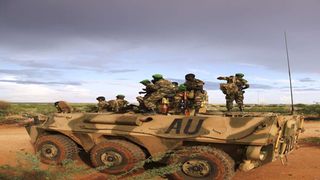

Somalia could be headed for some tough few months as foreign nations begin withdrawing their troops from the country after three decades of occupation, while the war-torn nation is in the middle of a tense election season.
Somalia, which has been unable to exist without the presence of foreign troops since the fall of Siad Barre in 1991, must, by the end of next year have the ability to keep her citizens safe from armed militia and terrorist groups.
The African Union Mission in Somalia (Amisom) has begun the last phase of handing over security responsibilities to the Somalia Security Forces ahead of withdrawal of its troops in December 2021 as stipulated in the UN Security Council Resolution 2520.
If the security situation remains the way it is in Kenya’s eastern neighbour, Somalia may not have the required capacity to keep her citizens safe by the end of next year when Amisom withdraws.
What is currently worrying observers, however, is the withdrawal of American troops as ordered by President Donald Trump. Some international media houses have reported that Ethiopia too, is reducing her military boots in Somalia.
The reduction of Ethiopian troops from her neighbour is, according, to Bloomberg meant to provide 3,000 more boots on the ground to help in dealing with the Tigray conflict in its own country.
“Ethiopia pulled back thousands of troops who’ve been helping Somalia’s government fight an Islamist insurgency. Their departure from Somalia comes as federal soldiers continue to battle forces loyal to the ruling party in the northern Ethiopian region of Tigray,” reported Bloomberg.
Over the weekend, America activated a joint task force that will oversee what it termed as a reposition of its forces from Somalia.
“I have directed the activation of a joint task force, JTF Quartz, built around the headquarters of Special Operations Command Africa to oversee Operation Octave Quartz, the directed repositioning of US Forces from Somalia to other bases in East Africa,” said US Africa Command (Africom) commander Stephen Townsend.
“To be clear, the US is not withdrawing or disengaging from East Africa. We remain committed to helping our African partners build a more secure future,” explained Gen Townsend “We also remain capable of striking the al- Shabaab at the time and place of our choosing. They should not test us.”
The US has about 700 troops in Somalia, which it wants to withdraw by January 15, just five days before President-elect Joe Biden takes over office. The US military mostly carries out counterterrorism missions, but also trains Somalia’s elite Danab Special Forces.
The US forces have also been collaborating with Amisom, especially the Kenyan confinement, in the drone pre-emptive attacks against al-Shabaab leadership. Pulling out American troops from Somalia could increase pressure on Amisom, which is also planning its own exit from the war-torn nation by the end of next year.
Amisom has 22,000 troops drawn from five countries who are members of the African Union (AU). UN Security Council Resolution 2520 allowed Amisom to maintain 19,626 personnel in Somalia until February 28, 2021.
The personnel are supposed to support security preparations for elections due at the end of 2020 or the beginning of 2021, and to conduct tasks in line with an updated Somali-led Transition Plan and the handover of security to Somali security forces.”
Under a strategy agreed in 2017 dubbed Somali Transition Plan, Amisom is required to gradually hand over its roles to Somali security forces, secure main supply routes, while conducting offensive operations that support the transition plan.
But with the political situation in Somalia continuing to heat up, America and Ethiopia’s sudden withdrawal of troops could create pockets of security vacuums that the al-Shabaab could take advantage of and try to regain lost ground.
“The potential for clan-based opposition and the al-Shabaab campaign present clear challenges in the run-up to the elections. The risks are high that Somalia could descend into further conflict should the electoral process be mismanaged,” said security think tank Crisis Group in its Watch List 2020–Autumn Update.
“Concrete evidence is hard to come by, but Mogadishu residents told Crisis Group that clans in the capital have been arming themselves in case disputes over the polls escalate into violence, portending a return to the clan-based fighting that damaged the country so badly in the 1990s,” said Crisis Group.
There are already troubling signs that the Islamist group could intensify attacks in Somalia in the coming days and weeks, as it did in the lead-up to the 2016 elections. And like it happened in 2016, there will be a spillover of such attacks to Kenya.
Last Friday, suspected al-Shabaab militants destroyed a telecommunications mast at Elele area in Mandera County, on the Somali border. The attack took place just four days after police houses were destroyed by an explosion at Borehole 11 in Mandera South Constituency, Mandera County.
vachuka@ke.nationmedia.com




No comments :
Post a Comment